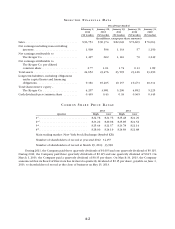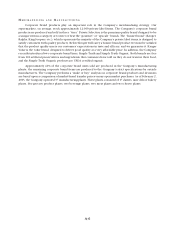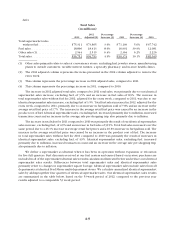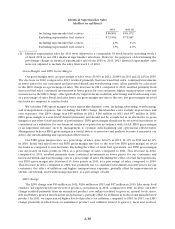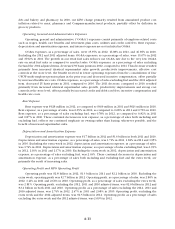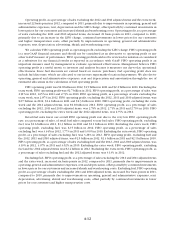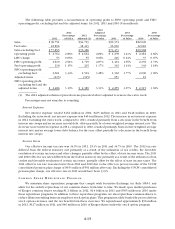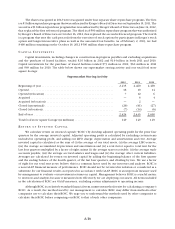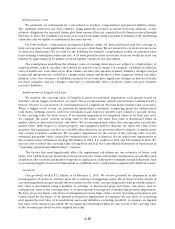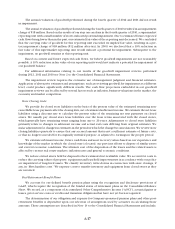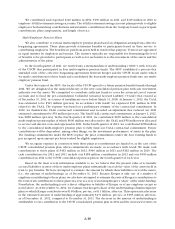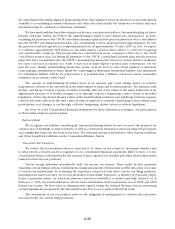Kroger 2012 Annual Report Download - page 68
Download and view the complete annual report
Please find page 68 of the 2012 Kroger annual report below. You can navigate through the pages in the report by either clicking on the pages listed below, or by using the keyword search tool below to find specific information within the annual report.
A-10
Identical Supermarket Sales
(dollars in millions)
2012 2011 (1)
Including supermarket fuel centers . . . . . . . . . . . $ 86,801 $ 83,072
Excluding supermarket fuel centers . . . . . . . . . . . $ 72,562 $ 70,087
Including supermarket fuel centers . . . . . . . . . . . 4.5% 9.2%
Excluding supermarket fuel centers . . . . . . . . . . . 3.5% 4.9%
(1) Identical supermarket sales for 2011 were adjusted to a comparable 53 week basis by including week 1
of fiscal 2012 in our 2011 identical supermarket sales base. However, for purposes of determining the
percentage change in identical supermarket sales from 2010 to 2011, 2011 identical supermarket sales
were not adjusted to include the sales from week 1 of 2012.
Gross Margin and FIFO Gross Margin
Our gross margin rates, as a percentage of sales, were 20.56% in 2012, 20.89% in 2011 and 22.24% in 2010.
The decrease in 2012, compared to 2011, resulted primarily from increased fuel sales, continued investments
in lower prices for our customers and increased shrink and warehousing costs, offset partially by a decrease
in the LIFO charge as a percentage of sales. The decrease in 2011, compared to 2010, resulted primarily from
increased fuel sales, continued investments in lower prices for our customers, higher transportation costs and
an increase in the LIFO charge, offset partially by improvements in shrink, advertising and warehousing costs
as a percentage of sales. Retail fuel sales lower our gross margin rate due to the very low gross margin on retail
fuel sales as compared to non-fuel sales.
We calculate FIFO gross margin as sales minus merchandise costs, including advertising, warehousing,
and transportation expenses, but excluding the LIFO charge. Merchandise costs exclude depreciation and
rent expenses. Our LIFO charge was $55 million in 2012, $216 million in 2011 and $57 million in 2010.
FIFO gross margin is a non-GAAP financial measure and should not be considered as an alternative to gross
margin or any other GAAP measure of performance. FIFO gross margin should not be reviewed in isolation or
considered as a substitute for our financial results as reported in accordance with GAAP. FIFO gross margin
is an important measure used by management to evaluate merchandising and operational effectiveness.
Management believes FIFO gross margin is a useful metric to investors and analysts because it measures our
day-to-day merchandising and operational effectiveness.
Our FIFO gross margin rates, as a percentage of sales, were 20.62% in 2012, 21.13% in 2011 and 22.31%
in 2010. Retail fuel sales lower our FIFO gross margin rate due to the very low FIFO gross margin on retail
fuel sales as compared to non-fuel sales. Excluding the effect of retail fuel operations, our FIFO gross margin
rate decreased 41 basis points in 2012, as a percentage of sales, compared to 2011. This decrease in 2012,
compared to 2011, resulted primarily from continued investments in lower prices for our customers and
increased shrink and warehousing costs as a percentage of sales. Excluding the effect of retail fuel operations,
our FIFO gross margin rate decreased 33 basis points in 2011, as a percentage of sales, compared to 2010.
This decrease in 2011, compared to 2010, was primarily due to continued investments in lower prices for our
customers, the effect of inflation and higher transportation expenses, partially offset by improvements in
shrink, advertising, and warehousing expenses, as a percentage of sales.
LIFO Charge
The LIFO charge was $55 million in 2012, $216 million in 2011 and $57 million in 2010. Like many food
retailers, we experienced lower levels of product cost inflation in 2012, compared to 2011. In 2012, our LIFO
charge resulted primarily from an annualized product cost inflation related to grocery, natural foods, meat,
deli and bakery, general merchandise and pharmacy, partially offset by deflation in seafood and manufactured
product. In 2011, we experienced higher levels of product cost inflation, compared to 2010. In 2011, our LIFO
charge primarily resulted from an annualized product cost inflation related to grocery, meat and seafood,




